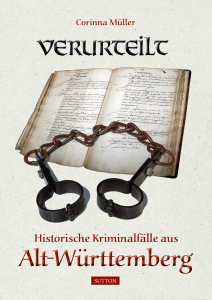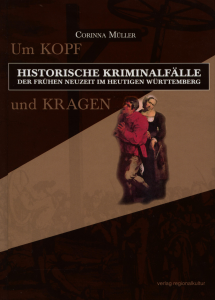
His parents assumed he was dead.
The grave digger did too. Well, maybe. If he thought it was strange that the corpse of the six-year-old child, two days after his purported death, vomited and hadn’t yet entered rigor mortis, he didn’t do anything about it. He buried the boy anyway. Grave diggers back in 1607 weren’t well educated – the community shepherd usually doubled as the town grave digger – and might not have been familiar with medical signs of vitality. Four children were buried that day in Murrhardt, Germany, and as was often the custom, they were buried together in one grave. After he lowered all four caskets, one on top of another, the grave digger heard it: pounding that sounded like it was coming from the inside of one of the coffins below him.

What happened next could have only one explanation. Fear of Wiedergänger, malevolent zombies who returned from the dead to exact revenge on the living, was rampant in 17th century Germany. The grave digger quickly shoveled a layer of dirt between himself and the threat and dashed to the nearest pub to tell about his narrow escape from the undead. Within hours, a local church official heard the story and was alarmed. He didn’t share the grave digger’s superstitions and ordered an immediate exhumation to rule out a live burial.
Townsfolk rushed to the cemetery and dug out all four coffins. The first three contained children who were clearly dead, but not the fourth. The fourth boy’s head was bleeding from fresh wounds. He’d apparently been hitting his head against the inner coffin walls. When a public officer placed a feather under the boy’s nose to see if he was still breathing, the feather moved. Then the boy’s eyes flicked open.
The people carried the boy to a nearby chapel, but the stress of his underground ordeal had been too much. He soon expired. He had been buried for eight hours. The grave digger was arrested and imprisoned in a tower to await trial.
But a trial for what?
This case threw down a gage to Germany’s criminal code, the Constitutio Criminalis Carolina. Heralded as revolutionary when it was first enacted in the 16th century, it recognized mitigating factors justifying milder sentences. For the first time, a judge could take age, illness, mental state, and other factors into account. Children, for instance, could be exonerated based on their age. Whether or not the grave digger committed murder or negligent homicide by burying a child alive depended on his ability to form intent. But intent to kill presumed awareness the victim was living. And that awareness, in turn, depended on his education and superstitions. Were they mitigating factors?
Murrhardt, Germany’s live burial provided the basis for the first of five short historical true crime stories in Corinna Müller’s new book, Verurteilt [Convicted]. I recently interviewed her, in German, and present the highlights below in English.
******************

Ann Marie Ackermann: Frau Müller, when I started your story about the live burial in Verurteilt, I felt as if someone had punched me in the stomach. And in the middle of the story, I noticed that I could hardly breathe. That’s how exciting it was.
Corinna Müller: That’s exactly how I felt when I first read the court file in the archives. That poor child! Eight hours underground…. And he came so close to being saved. I knew as soon as I read it I knew I needed to publish his story.
AMA: Were live burials a frequent occurrence in the 17th century?
CM: I’m afraid they occurred regularly. Württemberg, for instance, did not mandate medical examination of a body prior to burial until 1833. But to the extent that an accidental live burial was a crime, it was one that was very rarely detected. This case was one of the rare ones we know about. Judicially, it trod the boundaries of the legal definition of criminal homicide. Did the grave digger commit a crime or not? And if so, which one? This case was not only factually exciting, it was legally exciting.
AMA: You take on true crime cases in both your books that fall outside of the usual purview of the genre. Your stories also have to do with suspects who are exonerated, pardoned, or receive mitigated sentences.
CM: Law enforcement and the criminal justice system aren’t only there to arrest and convict. They are also there to exculpate innocent people and to find the appropriate punishment. I try to bring out all the facets of the justice system and strike the same balance in my true crime stories that law enforcement might see in practice. In fact, I recently published an article about a witch trial in which the defendant was found not guilty. My first book features another witch trial, from 1629. The defendant had cooked a skull because she thought it would bring the father of her children back from the dead. She was banished from her town, but not put to death. Banishment was still a severe punishment for a widow with children – who outside of town would accept a widow with two children? – but the court showed leniency. Literature on witch trials is obsessed with convictions and abuses of the system, and it is all too easy to overlook the successes. Often the old legal system operated quite fairly. I want to bring that out, along with the human drama and culture inherent in those stories.

Murrhardt’s live burial was one of those cases in which the 400-year-old German judiciary recognized grounds for leniency. Duke Friederich reviewed the case and decided that the eight days the grave digger had already spent in prison, awaiting trial, sufficed as punishment. The crime was at most negligent homicide. Had the court found him guilty of murder, it would have meant the death penalty.
Corinna Müller and I are sitting in a café in southern Germany, across from a baroque palace and small reflecting pool, sipping tea under the glow of Christmas lights. She speaks quietly, but her gestures and facial expressions broadcast a multi-tiered passion for historical crime. If the three elderly gentlemen seated next to us are disturbed by our conversation about live burials and witch trials, they don’t show it. When we offer them the brownies served with our tea (alas, we are both allergic to the ingredients), the men pilfer them gleefully.
AMA: Your legal analyses of a centuries-old criminal code are fascinating.
CM: So many people associate the Constitutio Criminalis Carolina with torture and witch trials and fail to see how progressive it was in comparison to prior medieval German criminal law. The CCC was a tidal wave of fresh water that washed out the injustices of the old system. It exonerated children and the mentally ill. It allowed for mitigated sentencing. Torture was allowed in the interrogation of witnesses, yes. Of course I don’t condone it. But most people don’t realize that under the CCC, torture could only be used if very strict requirements were met. Those reforms were incredibly liberal for their time.
AMA: Yes, but it was so easy for the officials administering torture to abuse the system.
CM: There are abuses in every system, unfortunately. But I have yet to find a documented case of an official abusing the CCC’s torture restrictions in Württemberg. [Württemberg is a state in southwest Germany.]

AMA: What were the restrictions?
CM: Probable cause was one: Concrete evidence that the suspect committed the crime, such as witness testimony or the suspect’s having been caught in the act, was a prerequisite to interrogation under torture. Then the CCC limited the duration of torture to one hour, and it could repeated only once. Neither leading questions nor yes-no questions were allowed. And if the court didn’t have outside witness testimony to corroborate a confession under torture, it was necessary for the suspect to reaffirm the confession while not under torture. That was to rule out admissions made just to avoid the pain. Physical or mental handicaps as well as pregnancy or having an unweaned baby rendered a suspect ineligible for torture.
AMA: Before you starting writing true crime, you used to work for the police force.
CM: Yes, for the “Kripo,” or Kriminalpolizei, as a detective. I processed crime scenes – homicides, drug cases, sexual offenses, and the like. Suicides as well. It included all the work involved after patrol officers made the initial response to a crime scene.
AMA: How did the detective become a true crime writer?
CM: I had to quit the police force due to health reasons, and in my new-found free time started researching genealogy. I attended a genealogy conference and someone gave a speech about a witch trial. It fascinated me. The speaker then asked me to help research a historic criminal case, and I got hooked. And that led to my first true crime publication.

AMA: What was the hardest part about the switch?
CM: Learning how to decipher the old German handwriting was a challenge! That took awhile. Several archivists helped me, and with practice, I can read it fairly well now. In addition, the language and vocabulary have changed. And many historic legal documents also used Latin.
AMA: Does any of your law enforcement experience transfer to your historical research and writing?
CM: If anything, it would be a detective’s approach or mindset. In law enforcement, I didn’t stop asking questions of the evidence, the witnesses, and of myself until I felt like I’d gained a complete understanding of the case. I try to do the same with my research material. Curiosity is my motor.
AMA: Thank you, Fr. Müller!
How would have you decided this case if you were Duke Friedrich and had the last say?
Books by Corinna Müller (unfortunately available only in German):
Verurteilt: Historische Kriminalfälle aus Alt-Württemberg [Convicted: Historical Criminal Cases from Old Württemberg] (Erfurt: Sutton Verlag 2014)
Um Kopf und Kragen: Historische Kriminalfälle der Frühen Neuzeit im heutigen Württemberg [When Your Life is on the Line: Historical Criminal Cases of the Early Modern Era within the Current Boundaries of Württemberg] (Ubstadt-Weiher: Verlag Regionalkultur 2011)




I’d put him in a coffin and bury him (with air tube) for a few hours, then dig him up.
Maybe some rudimentary education for all grave diggers would have helped more.
I figured being buried would be highly educational. Afterwards he’d run to the pub and educate the others.
Thomas a Kempis, author of The Imitation of Christ, was buried alive. This fact discovered when he was exhumed to see if his body was incorrupt. His hair was in his hands. This prevented his canonization since no one could know of his last time alive.
I seem to recall having read that somewhere, Margaret. Wasn’t it also the feeling that his inability to accept his fate spoke against sainthood? If so, there seems to have been a failure to recognize that the fear of death is a God-given instinct designed to ensure our species’ survival. Do you think the church today would hold panic in a coffin against canonization?
At any rate, I’ve heard a number of stories of people who were buried alive and did the exact same thing — ripped their hair out. In this case, the boy’s hands were bound to his body. He couldn’t have ripped out his hair. That’s also why he used his head to pound against the coffin walls.
The modern practice of embalming eliminates the risk of live burial. But embalming never became popular in Germany and it still isn’t done today, except perhaps for a state funeral. Fear of being buried alive became so widespread in Germany in centuries past that a three-day waiting period between death and burial was instituted. That practice is still followed today, so long as the deceased’s religion allows it, but modern medicine’s ability to confirm death has made the awakening of a body in the so-called Leichenhalle a very rare event.
What a fine interview! I felt like I was there with the author and would have asked the same questions, if I could think of them. Thanks for expertly filling in the blanks of my thoughts with your own curiosity that naturally flowed from such a haunting topic.
Thanks, Dwight. Corinna Müller and her stories really do fascinate me.
The fear of being buried alive must go very deep. It also made me click on the link, so there you go. The Thomas a Kempis information in the comments is as horrific to me as the original story. Not just because of what he went through, but because of what it says about the [excuse me] @$% church.
I can imagine, Paula, that churchmen who decided not to canonize Thomas a Kempis were also saddled with superstitions, just like grave digger in the original story, so that it makes it hard for us today to judge their actions. I’m just glad our society today has shed those superstitions — and that modern medicine has made live burials an extremely rare event.
It must have been terrifying for that child to wake up in his coffin. You did a wonderful job showing what that experience might have been like.
This book sounds great!
Thanks, Lydia! Yes, it must have been terrifying. I have to credit the author of the book, Corinna Müller, with painting that terror with such dramatic brush strokes. Her book is only available in German. It sure would be nice if it could get translated into English!